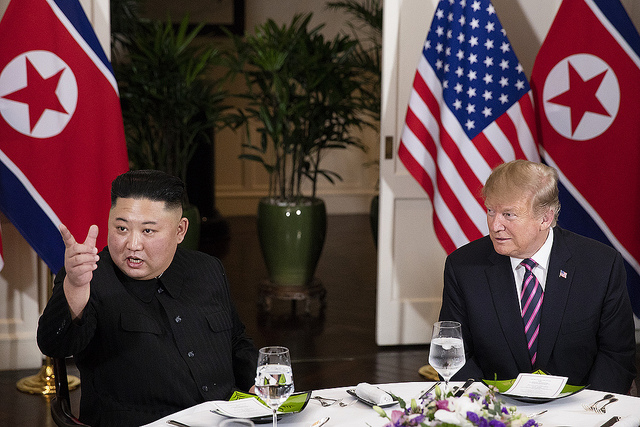 Photo Courtesy: The White House on Flickr
Photo Courtesy: The White House on Flickr
Kim Won’t Stop Sending Mixed Messages
On February 27th-28th, President Trump and Chairman Kim held their second summit in Hanoi, discussing the possibility of reaching an agreement over North Korea’s denuclearization and the easing of the UN sanctions which are currently limiting the country’s business capabilities. On March 2nd, merely two days after the summit, experts presented evidence that North Korea started re-building a rocket launch site at Sohae Satellite Launching Station, a military base located roughly 130 miles from the capital.
Despite this, on March 3rd President Trump announced he was going to suspend the annual military drills that typically take place in the spring. These exercises, known as Key Resolve and Foal Eagle, serve as joint training between the US and South Korean militaries in preparation for a potential intervention.
The decisions made by the two leaders in the aftermath of the Hanoi summit don’t seem to line up. While Kim’s re-opening of Sohae is a clear step back in their diplomatic relationship, Trump’s decision to cancel the drills looks like an attempt to reconcile with North Korea despite a failed summit.
Sohae Satellite Launching Station had been closed for more than five months before Kim decided to re-open it. As a matter of fact, in the summer of 2018 the North Korean leader decided to close it in an attempt to extend an olive branch to the US.
How should we then interpret Kim’s actions? And how will this affect the development of Trump-Kim negotiations?
There are several factors that suggest Sohae’s re-opening should be taken as a manifestation of dispute, rather than a sign of imminent threat.
Firstly, the re-building of the rocket launch site doesn’t automatically entail that North Korea is going to be testing or deploying ICBMs. It may merely be an effort to encourage the US to come back to the negotiating table out of fear of North Korea reengaging in testing efforts.
What is more, North Korea is known for making memorable gestures for the sole reason of making an impression on foreign public opinion. For instance, North Korea made a grand display of shutting down the Punggye-ri nuclear texting complex in May 2018 – but the site’s destruction wasn’t witnessed by any nuclear and nonproliferation expert, and though the tunnel leading to the nuclear site was destroyed, the facility itself may not have been.
The way Kim really intended Sohae’s re-opening was as a message of endurance: he won’t submit to Trump’s requests if they aren’t coupled with easing sanctions—a measure that Trump postured won’t take place until North Korea surrenders all its chemical, biological, and nuclear weapons.
What is particularly worrying, though, isn’t this single episode. As a matter of fact, the re-opening of the station seems to fit in a pattern of behavior that would suggest Kim doesn’t seriously intend to reach an agreement that satisfies or placates US concerns.
For one, reports indicate there are more than a dozen missile operating bases that are still being concealed by the North Korean government. Also, analysists are considering the possibility that North Korea actually started to re-build Sohae well before the Hanoi summit, and might therefore be reconditioning the station with the purpose of actually using it. Alternatively, this could be part of contingency plans enacted in anticipation of the summit’s failure.
Given all of this, Kim is likely putting up a façade when claiming sincerity, such as when he stated he wouldn’t even have gone to the Hanoi summit if he hadn’t been sincerely considering denuclearization, and that he’d be willing to establish an American liaison office in North Korea.
Rather than wonder whether or not Kim is genuine about negotiating, one should assume he is attempting to reach an agreement that is favorably biased to his goals, and doesn’t fully surrender his nuclear deterrent. President Trump should not trust Kim’s sincerity, but should consider making smaller offers designed to test his intent, so as to find possible paths forward. Even if Trump does eventually, get Kim to agree to denuclearize, the US must insist on establishing strict, invasive verification mechanisms.
What’s certain is that it is imperative not to nullify the efforts taken by both leaders to hold the two summits. While there is a great deal of disagreement, the process of communicating in an effort to resolve those disagreements is beneficial. After all, talking is preferable to fighting.





